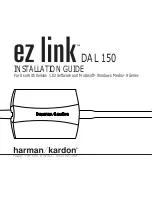
Dynamic TEACH
Dynamic TEACH is used to program sensitivity during actual machine run conditions. During
Dynamic TEACH, the R55F samples many color marks against their background material and
automatically sets the sensitivity at the optimum level. Dynamic TEACH activates the sensor’s
adaptive threshold system, which continuously tracks minimum and maximum signal levels, and
automatically maintains centering of the switch point between the light and dark conditions. The
adaptive threshold system remains in effect during RUN mode to automatically adjust for changes
in the light or the dark conditions.
When Dynamic TEACH mode is used to program sensitivity, the output ON state must be assigned
to either the light or dark condition using the SETUP mode (see page 7).
Sensitivity may be adjusted at any time when the sensor is in RUN mode by clicking the “+” and “-”
buttons. However, when a manual adjustment is made, the adaptive threshold system is disabled
(cancelled).
Dynamic TEACH Procedure - Push button
R55F Series Fiber-Optic Color Mark Sensors
Push Button
Resulting Indicator Status
Press and hold DYNAMIC
button until LO and DO
indicators alternately flash.
SETUP
DO
LO
OFF
Delay
Switch Point
+
DYNAMIC
–
ST
A
TIC
Press and Hold
≥
2 seconds
LO and DO: Alternately flash green
: OFF
Light Bar: Goes OFF
Continue depressing the
DYNAMIC button while
sampling light and dark
sensing conditions.
SETUP
DO
LO
OFF
Delay
Switch Point
+
DYNAMIC
–
S
TAT
IC
Continue to Depress
While Sensor Samples
Light and Dark Conditions
LO and DO: Alternately flash green
: OFF
Light Bar: Remains OFF
Release the DYNAMIC button
when finished sampling light
and dark sensing conditions.
SETUP
DO
LO
OFF
Delay
Switch Point
+
DYNAMIC
–
S
TAT
IC
Release
Contrast accepted: one of the ten
segments flashes for three seconds to
indicate relative contrast, and the sensor
enters RUN mode.
Contrast too low: five light bar segments
flash for three seconds to indicate low
contrast, and sensor reverts to the
previously taught conditions.
NOTES:
1) If the sensing conditions are accepted at the end of Dynamic TEACH, the signal strength light bar flashes one
of its ten segments for three seconds to indicate relative sensing contrast. The higher the flashing segment,
the higher the measured sensing contrast. High contrast relates directly to sensing reliability. High contrast
sensing applications are most tolerant of sensing variables, such as web flutter or variations in color mark
color or print density.
2) If the sensor does not measure enough contrast at the end of Dynamic TEACH, every other segment of the
signal strength light bar flashes in unison for three seconds to warn of unacceptably low contrast, and the
sensor returns to RUN mode with its previously taught conditions.
See page 8 for Remote
TEACH procedures
Buy: www.ValinOnline.com | Phone 844-385-3099 | Email: [email protected]






























